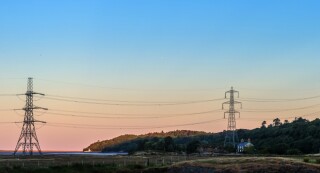Some 22 pylons in the Dorset Area of Outstanding Natural Beauty (AONB) are coming down over the next three months and work has begun to transform views across the Dwyryd Estuary, by ultimately removing 10 pylons and a 3km stretch of overhead power lines.
The projects – at very different stages – are part of National Grid’s visual impact provision, or VIP, project.
In Dorset, near the villages of Martinstown and Winterbourne Abbas, National Grid and its contractor Morgan Sindal have started to remove 22 pylons and 8.8km of overhead cable. The powerlines have been buried underground instead.
National Grid senior project manager Paul Hamnett said: “This is the culmination of three years of complex engineering and construction work which would not have been possible without the dedication and expertise of the site team and the patience of the local community. Our goal has always been to enhance this beautiful landscape, and now we’re seeing the fruits of our labour with the fields we used for civil engineering works being reinstated and, ultimately, the successful removal of 8.8km of overhead cables and 22 pylons.”
Meanwhile, in Snowdonia, National Grid is in the very early stages of pylon removal. Hochtief UK is preparing to build a tunnel under the Dwyryd Estuary to house power cables. With guidance from Gwynedd Archaeological Trust, the team has begun archaeological survey works in Garth as part of work to establish the construction site near National Grid’s existing land. Ecological surveys and habitat management work have already taken place over the summer on the opposite side of the estuary in Llandecwyn, led by Mold-based Atmos Consulting. This included vegetation clearance, the installation of perimeter fencing and creation of ‘refugia’ to help safely trap and relocate reptiles from the site.


This initial site preparation work will be followed from 2023 onwards with a programme of shaft sinking, tunnel and head house construction, cable installation and commissioning. Pylon removal is expected to take place following this, in 2029.
Steve Ellison, National Grid senior project manager for Snowdonia VIP, said: “The VIP project is unique. It’s one of the very first projects in the world to remove existing high-voltage electricity transmission infrastructure solely to enhance the landscape. With the project set to take several years to complete, we’re absolutely focused on working with Hochtief UK to get it right.
“The engineering challenges of the project require lots of different specialist skills to deliver it successfully, including the construction of a tunnel deep underneath the Dwyryd Estuary to house the new underground cables. The site preparation work we’re doing now is key to putting important foundations in place for the project.”
There is also planning consent for a VIP pylon removal project in the Peak District National Park . The North Wessex Downs AONB is due to submit its planning application shortly, and a potential project in the Cotswolds AONB is in the early stages of planning.
Got a story? Email news@theconstructionindex.co.uk


